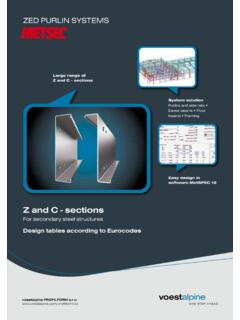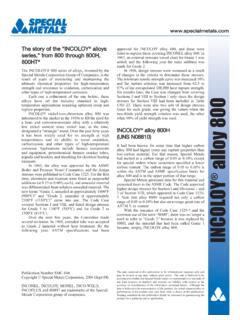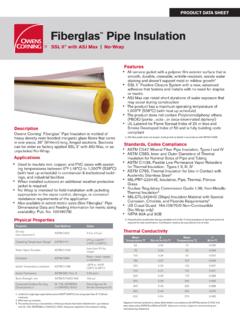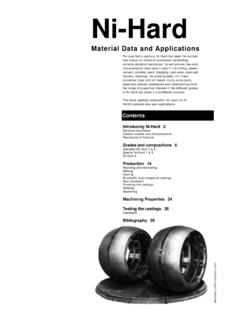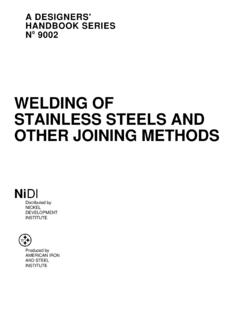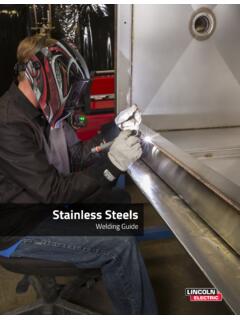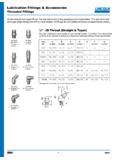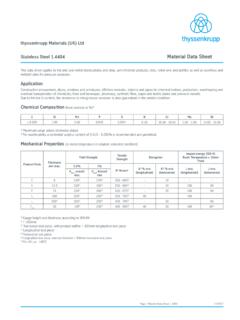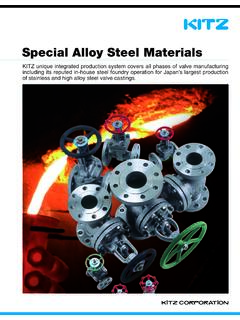Transcription of MANUAL FOR SURFACE TREATMENT OF STAINLESS STEELS
1 Voestalpine B hler ConnectionsMANUAL FOR SURFACE TREATMENT OF STAINLESS STEELS2 MATCHLESS IN STAINLESSB hler Welding weldCare is a leading producer of superior pickling products for STAINLESS STEELS and special alloys. For over 50 years B hler Welding weldCare has worked closely with leading producers of STAINLESS steel and offers exten-sive knowledge and a wide range of finishing chemicals: Pickling Gels Pastes Sprays Liquids and Cleaning weldCare Finishing Chemicals will restore the SURFACE and return STAINLESS steel to it s original look. STAINLESS steel retains its beautiful finish thanks to a protective layer that forms on the SURFACE . The products help to maintain or restore this protective layer and help customers around the world in their daily work of creating a superior STAINLESS steel products are made in Malm , Sweden, in our own modern, automated process plant.
2 All products have full traceability from raw material to finished product, which gives us total control of the product quality. Our quality and environmental management systems are certified according to the ISO 9001 and ISO 14001 standards. LASTING CONNECTIONSAs a pioneer in innovative welding consumables, B hler Welding offers a uni-que product portfolio for joint welding worldwide. More than 2000 products are adapted continuously to the current industry specifications and customer requi-rements, certified by well-respected institutes and thus approved for the most demanding welding applications. Our customers benefit from a partner with the highest expertise in joining, rendering the best application support globally available specialized and best in class product solutions for their local and global challenges an absolute focus on customer needs and their success a worldwide presence through factories, offices and distributors LASTING CONNECTIONS3 CONTENT1.
3 STAINLESS STEELS AND THE NEED FOR CLEANING .. STAINLESS steel grades and cleaning .. SURFACE finishes and cleaning .. Welding methods and cleaning .. Correct handling and cleaning .. Industrial trends and cleaning .. Typical defects .. Heat tint and oxide scale .. Weld defects .. Iron contamination .. Rough SURFACE .. Organic contamination .. 132. CLEANING PROCEDURES .. Mechanical methods .. 142 .1 .1 . G r i n d i n g .. Blasting .. Brushing .. Summary .. Chemical methods .. Pickling .. Passivation and decontamination .. Electropolishing .. Choice of method .. Examples of a complete cleaning process .. Case details .. 203. CHEMICAL METHODS IN PRACTICE.
4 B HLER WELDING WELDCARE PRODUCTS .. General requirements .. Precleaning/degreasing .. Pickling .. Pickling with paste .. Pickling with solution (spray-pickling gel) .. Typical pickling times for brush and spray pickling .. Pickling in a bath .. Fume reduction during pickling .. Passivation and desmutting .. 324. NEUTRALISATION AND WASTE TREATMENT .. Neutralisation .. Waste TREATMENT .. 335. INSPECTION AND TROUBLESHOOTING .. Test methods .. Troubleshooting .. 356. SAFE HANDLING AND STORAGE OF PICKLING PRODUCTS .. Safety rules .. Personal safety .. Storage .. 37 REFERENCES .. 38 IMPORTANT NOTICE! .. 384 STAINLESS STEELS AND THE NEED FOR CLEANING5A good STAINLESS steel SURFACE is clean, smooth and fault-less. The importance of this is obvious when STAINLESS steel is used in, for example, fa ades or applications with strin-gent hygiene requirements.
5 However, a fine SURFACE finish is also crucial to corrosion steel is protected from corrosion by its passive layer a thin, impervious, invisible, SURFACE layer that is pri-marily chromium oxide. The oxygen content of the atmo-sphere or of aerated aqueous solutions is normally sufficient to create and maintain ( self-heal ) this passive layer. Unfor-tunately, SURFACE defects and imperfections introduced during manufacturing may drastically disturb this self-hea-ling process and reduce resistance to several types of local corrosion. Thus, as regards hygiene and corrosion, a final cleaning process is often required to restore an acceptable SURFACE extent of, and methods for, post-fabrication TREATMENT are determined by a number of factors. These include: the corrosivity of the environment ( marine); the corrosion resistance of the steel grade; hygiene requirements ( in the pharmaceutical and food industries); and, aesthetic considerations.
6 Local environmental requirements must also be considered. Both chemical and mechanical clea-ning methods are design, planning and methods of manufacture can reduce the need for post- TREATMENT and thus lower costs. When manufacturing to SURFACE quality specifications, the impact of defects and, ultimately, the cost of removal must be borne in cost of treating/cleaning is small compared to the ini-tial capital expenditure on a piece of equipment. It is also small compared to the continuing operational cost of not are two main elements in the economics of post-fa-brication cleaning the cost of cleaning and the benefits that cleaning brings as regards long-term performance. Fabrication can reduce the overall corrosion performance of a STAINLESS steel to below its normal level. Furthermore, in real conditions, it is difficult, if not impossible, to com-plete the fabrication of a significant facility or piece of equipment without some SURFACE they generally have relatively poor corrosion per-formance, areas that have not been cleaned after fabri-cation are essentially the weak link in the chain.
7 Depending on the extent of cleaning required, TREATMENT after cons-tructing a tank (for example) might cost as little as 1 3% of the total spent on materials and manufacture. Conse-quently, as it maximises the return on the investment, post-fabrication cleaning is not expensive (see also ref. 9).1. STAINLESS STEELS AND THE NEED FOR CLEANINGB eforeAfter6 DefinitionsThe following terms are often imprecisely used: cleaning; post-fabrication cleaning; precleaning; descaling; pickling; passivation; and, desmutting. For a better understanding of SURFACE TREATMENT and this publication, it is important to define these includes all operations necessary to ensure the removal of SURFACE contaminants from metals and: Maximise the metal s corrosion resistance. Prevent product contamination. Achieve the desired of grinding, degreasing, pickling and pass-ivation may be necessary to obtain a clean cleaning is the process of cleaning after fabrication.
8 Its purpose is to remove all contamination asso-ciated with the fabrication is the removal of grease, oil, paint, soil, grit and other coarse contamination prior to pickling or final is the removal of grease prior to pickling or final is the use of chemicals to clean a metal by remo-ving: defects; the SURFACE film of inherent or thickened oxide; and, below this, some micrometres of the parent is a too strong etching of a SURFACE with pick-ling acids. This leaves a rough SURFACE that may result in a lowering of the metal s is toxic nitric fumes (NO and NO2) formed during the pickling is the name applied to a number of different processes related to STAINLESS steel . Unless otherwise spe-cified, passivation in the present context is the chemical TREATMENT of a STAINLESS steel with a mild oxidant so as to remove free iron from the SURFACE and speed up the pro-cess of forming a protective/passive layer.
9 However, pass-ivation is not effective for the removal of heat tint or oxide scale on STAINLESS is an undesired discoloration or deposit on a SURFACE after pickling (can appear as a dark adhesive film). These dark spots can indicate that there are some remaining con-taminants on the steel and that these have interfered with the pickling is the removal of smut. Desmutting is neces-sary if dark areas appear on a SURFACE during pickling. This can be overcome by applying more pickling spray to these spots or by applying a passivator until they disappear. This must be done when the SURFACE is still wet ( wet on wet ), just before the pickling spray is rinsed methods:MMA: MANUAL metal arc (SMAW = shielded metal arc welding)MIG/MAG:metal inert/active gas (GMAW, gas metal arc welding)TIG:tungsten inert gas (GTAW = gas tungsten arc welding)SAW:submerged arc weldingFCAW:flux cored arc weldingMCAW:metal cored arc STAINLESS steel GRADES AND CLEANINGIn any application, STAINLESS steel grades are selected on the basis of required properties ( corrosion resistance), design criteria and fabrication requirements.
10 However, there are many different iron-carbon-chromium alloys that are collectively referred to as STAINLESS micro structures of different STAINLESS steel gradesFerritic11 17 % Cr+Ni+C++NiDuplex21 26 % CrMartensitis11 17 % CrAustenitis18 30 % CrSTAINLESS STEELS AND THE NEED FOR CLEANING7A pickled, duplex 2304 storage tankA steel s corrosion resistance, weldability, mechanical properties, etc are largely determined by its microstructure (see figure 3). This, in turn, is determined by the steel s chemical composition. As per EN 10088, STAINLESS STEELS can be divided into the following, basic, microstructure-dependent groups: Martensitic. Ferritic. austenitic . austenitic -ferritic (duplex).As they are normally added to increase corrosion resistance, the various alloying elements have a large impact on the ease with which a STAINLESS steel can be pickled (pickleability).

